What is solar radiation?
The sun is the earth's major energy source and radiates its energy from a distance of 150 million kilometers, or 8.3 light minutes. This solar radiation reaches the outside of our atmosphere with an irradiance of about 1360 Watts per square meter (W/m2). It covers the spectrum from ultraviolet, through visible, to near infrared wavelengths. Most important solar irradiance spectral categories are presented in the table below.
| Ultraviolet | 100 nm ≤ λ < 280 nm | UVC (ultraviolet C) |
| 280 nm ≤ λ < 315 nm | UVB (ultraviolet B) | |
| 315 nm ≤ λ < 400 nm | UVA (ultraviolet A) | |
| Visible light | 450 nm ≤ λ < 500 nm | blue |
| 70 nm ≤ λ < 591 nm | yellow | |
| 610 nm ≤ λ < 760 nm | red | |
| Infrared | 760 nm ≤ λ < 1.4 μm | IR-A (near infrared) |
| 1.4 μm ≤ λ < 3 μm | IR-B (middle infrared) | |
| 3 μm ≤ λ < 1 mm | IR-C (far infrared) |
TABLE 1: Some important solar irradiance spectral categories
Source: ISO 21348, Space environment (natural and artificial)
Process for determining solar irradiances
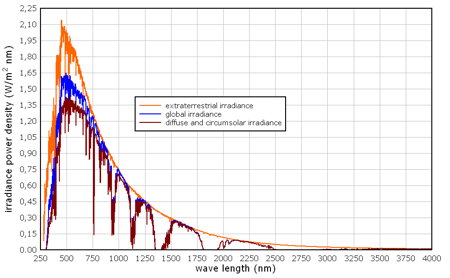
ASTM G173-03 Reference Solar Spectral Irradiance
data credit: Renewable Resource Data Center (RReDC):
Standard Solar Spectra
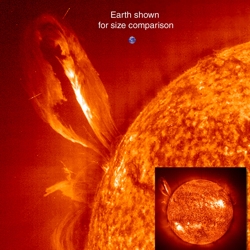
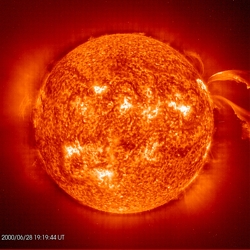
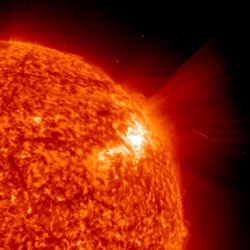
Sun, credit:
NASA/SDO
Components of solar radiation at the Earth's surface
When solar radiation reaches the top of the Earth's atmosphere it can be considered as a parallel beam coming in a straight line from the sun. By the time this beam reaches the earth's surface, it has traveled through the atmosphere and changed its composition through scattering, diffusion and absorption. This is caused by gasses, water vapour, particles and clouds. Some of the absorbed energy is re-radiated in the far infrared. Light is scattered differently by the atmosphere depending upon its wavelength, and this results in the blue sky during the day and the red colour at sunrise and sunset. As a result of these effects, three components can be distinguished at the surface; direct, diffuse, and global solar radiation. The first are the solar rays travelling in a straight line from the sun which were not scattered or absorbed by the atmosphere. The second is solar radiation which has been diffused by the atmosphere and clouds and, as a result, is coming from all directions of the hemisphere. Finally, global solar radiation is the sum of the direct and diffuse solar radiation irradiating a flat horizontal surface. In this case, the contribution of the direct beam component is proportional to the cosine of the angle between the position of the sun in the sky and the normal (vertical) to the horizontal surface.
Why should I measure it?
Good quality, reliable solar radiation data is becoming increasingly important in the field of renewable energy, with regard to both photovoltaic (PV) and thermal systems. It helps well-founded decision making on activities such as research and development, production quality control, determination of optimum locations, monitoring the efficiency of installed systems and predicting the system output under various sky conditions. Especially with larger solar power plants, errors of a few percent can significantly impact upon the return on investment.
What do I measure with?
Global radiation is measured with pyranometers, which are radiometers designed for measuring the total (global) irradiance on a plane surface. Direct radiation is measured with a pyrheliometer that has a slightly larger view than the sun and its aureole and does not see the rest of the sky. To make measurements the pyrheliometer must point precisely at the sun and this is achieved by using an automatic two-axis sun tracker. A shading assembly on the sun tracker is used to block the direct radiation from a pyranometer so that it measures only the diffuse sky radiation.
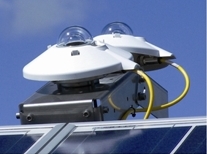
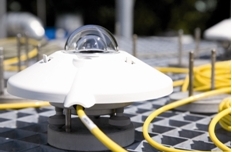
Horizontal and tilted pyranometer - left, courtesy
skytron energy
Pyranometer CMP1 - right, courtesy:
Kipp & Zonen
What instruments do I need for my installed system?
PV panels have a wide field of view and are positioned to receive the maximum amount of solar radiation. Therefore, in addition to the horizontally mounted pyranometer it is recommended to have another pyranometer fixed to the panel or array to measure the energy available from the hemisphere that the panel can see, the 'tilted' global radiation. This allows the system efficiency to be monitored and maintenance, such as cleaning, to be scheduled. Concentrating PV systems use lenses to collect and focus the sun's radiation onto the cells. Thermal solar energy systems use reflectors to focus the radiation onto a target to be heated. Both have a relatively small angle of view and it is important to know the amount of radiation available directly from the sun. In this case a pyrheliometer mounted on a sun tracker is used to monitor the energy available. Depending upon the atmospheric conditions, 10 % or more of the incoming energy is far infrared radiation from the sky and clouds that could be utilized by thermal solar energy systems. This can be measured using a pyrgeometer. Pyranometers and pyrheliometers make technology-independent and widely comparable measurements and their calibrations are traceable to the World Radiometric Reference at the World Radiation Centre in Davos, Switzerland.
Why Kipp & Zonen?
Kipp & Zonen has been designing and manufacturing solar radiation measurement equipment for over 80 years and supplies leading meteorology and climatology organizations, research institutes and energy companies around the globe. Our radiometers are constantly improved and adapted to customer requirements. They can help you to optimize the performance of your systems. In addition to radiometers and sun trackers the product range includes accessories, data loggers and interfacing solutions. All products have a 2-year warranty and Kipp & Zonen has a world-wide reputation for quality, reliability, expertise and support. Large portion of the text on this page was published with courtesy of company Kipp & Zonen. For more information about Kipp & Zonen products, applications, customer stories and news please visit their website at www.kippzonen.com/energy.
Solar radiation Measurement Equipment
Pyranometers and pyrheliometers are most common used instruments for solar irradiance measurements. Pyranometers are used for global irradiance measurements typical in the wavelength range from 300 to 3000 nm - UV light to infra red radiation. In low cost models silicon photo diodes are used as sensor but in professional instruments thermopiles are used. Pyranometers do not require much maintanance and are designed for long life service. Such instruments are daily used by weather monitoring organizations for example.
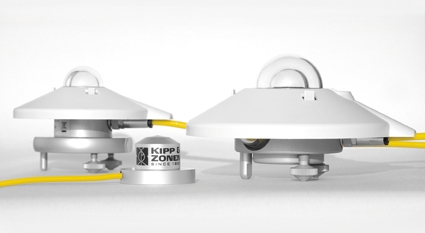
Pyranometers SP Lite2, CMP 3 and CMP 11, courtesy: Kipp & Zonen
Good quality solar radiation data is becoming increasingly important in the field of renewable energy with regard to both photovoltaic (PV) and thermal systems. This applies in activities such as research and development, production quality control, determination of optimum locations, monitoring the efficiency of installed systems and predicting the system output under various sky conditions. Radiation arriving at the Earth's surface from the sun and the sky is split into short-wave radiation (ultraviolet, visible and near infrared) in the wavelength range 300 to 4000 nm (4 μm) and long-wave radiation (far infrared) from 4.5 to beyond 40 μm. PV materials have most of their sensitivity from approximately 400 to 1100 nm, with a peak just beyond the visible range. There is no response to long-wave radiation, and little to ultraviolet. Measurements of solar radiation are usually made using thermopile type radiometers with a flat spectral response. The types of instruments are defined by the World Meteorological Organisation (WMO) and the International Standards Organisation (ISO). In a solar monitoring station the short-wave radiation is measured in three ways:
Global Solar Irradiance is measured by a Pyranometer, which is a radiometer with a glass dome that has a hemispherical view of the whole sky.
Direct Solar Irradiance is measured by a Pyrheliometer. This is a radiometer with a 5° view that is pointed accurately at the centre of the sun by an automatic Sun Tracker. It only sees the sun and its aureole.
Diffuse Solar Irradiance is scattered by aerosols in the atmosphere and reflected by clouds. It is measured by a Pyranometer mounted on a sun tracker with a shading mechanism to block the direct solar irradiance.
The output signals are normally acquired by a high accuracy multi-channel data logger that is programmed with the sensitivity of each radiometer, so that data can be stored in units of W/m2. However, for applications such as monitoring the efficiency of a PV installation, it is sufficient to use a single pyranometer measuring the total solar energy available. This could be permanently installed (horizontally or at the same angle as the PV panels) or used with a hand-held display for field checks.
| ISO classification | |
| Response time | s |
| Non-stability | % (changes/year) |
| Non-linearity | % |
| Sensitivity | μV/W/m2 |
| Impedance | Ω |
| Operating temperature | °C |
| Spectral range | nm |
TABLE 2: Pyranometers, some important technical data
Source: ISO 9060 - Solar energy - Specification and classification of
instruments
for measuring hemispherical solar and direct solar radiation
A Pyrheliometer is an instrument designed specifically to measure the direct beam solar irradiance with a field of view limited to 5°. The front front aperture is fitted with a quartz window to protect the instrument and to act as a filter that passes solar radiation between 200 nm and 400 nm. Other professional instruments include pyrgeometers for measurement of far infrared radiation, albedometers for albedo measurements, UV radiometers for solar UV measurements etc.
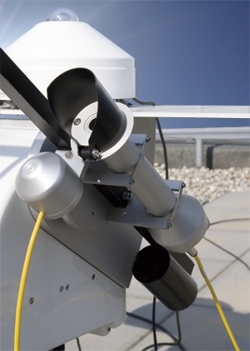
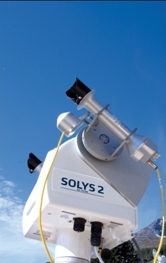
Pyrheliometer, model CHP1, courtesy: Kipp & Zonen
Kipp & Zonen is the leading specialist for solar radiation instruments. They offer a wide range, from the highest accuracy to cost-effective solutions. They are the main supplier of pyranometers and pyrheliometers to the PV Industry and the demanding fields of meteorology and climatology at measurement sites around the world. More information on Kipp & Zonen web site.
Solar Radiation Radiation Maps and GIS Databases
Focus Solar - at Focus Solar, we master the art of solar resource estimation. That's the study of how much energy is provided by the sun under different weather conditions. The use of satellite earth observations has brought a whole new dimension to solar resource assessment. Solar home systems and solar power plants can now be planned, operated, and optimized with the support of high-tech instruments from NASA's weather satellites.
Geomodel - high resolution solar radiation and temperature data for any location or region, solar maps, and simulation tools for solar energy technologies (PV, CSP, CPV, solar heating/cooling).
Photovoltaic Geographical Information System - PVGIS, Geographical Assessment of Solar Resource and Performance of Photovoltaic Technology. Calculations for European teritory, Mediteranian region and Africa are available.
Professional measurement equipment producers
Kipp & Zonen - Kipp & Zonen offers high quality solutions for the measurement of both natural and simulated solar radiation, from the ultraviolet to the infrared, for both photovoltaic and thermal solar energy systems.
Campbell Scientific - Campbell Scientific offers pyranometers, net radiometers, and quantum sensors, all designed to measure various aspects of the energy imparted by the sun on the Earth's surface.
EKO Instruments - EKO developing and manufacturing various kinds of Pyranometers since 1955.
apogee instruments - apogee instruments produces pyranometers and other short wave measuring equipment.
Other instruments and sensors
SoluzioneSolare - SoluzioneSolare provides a product range of monitoring instruments specifically studied to support installers in their work.
MacSolar - MacSolar Irradiation measuring devices.
Solarmeter - The Model 10.0 features an Integral Sensor and applications include solar irradiance measurements, solar panel (photovoltaic) system testing and estimation of PV array power.
NES - Mess- und Meldesysteme - Silizium-Solar-Einstrahlungssensoren.
skytron energy - Monitoring and control concepts from skytron® energy make your photovoltaic installation controllable just like any conventional power generation plant.
Other Web Sites
World Radiation Center - The Physikalisch-Meteorologisches Observatorium Davos (PMOD) was founded in 1907. In 1971, the PMOD was designated by the World Meteorological Organization (WMO, Geneva) to serve as a World Radiation Center (WRC).
The Atmospheric Radiation Measurement Program - The Atmospheric Radiation Measurement Program (ARM) is the largest global change research program supported by the U.S. Department of Energy (DOE). ARM scientists focus on obtaining field measurements and developing models to better understand the processes that control solar and thermal infrared radiative transfer in the atmosphere (especially in clouds) and at the earth's surface.
HIM - Wettershop - online shop with wide range of high quality and wellproved meteorological and hydrological measurement instrumens for professional application as well as for ambitious amateurs.
Recommended Books - Solar Radiation Measurement
|
|
Vignola, F. et al. (2012), Solar and Infrared Radiation Measurements (Energy and Environment), CRC Press, ISBN 978-1439851890. |
|
|
Srivastava, G.P. (2008), Surface Meteorological Instruments and Measurement Practices Atlantic Publishers & Distributors, ISBN 978-8126909681. |
|
|
Hulstrom, R. L. Ed. (1989), Solar Resources (Solar Heat Technologies), Fundamentals and Applications; MIT Press, Cambridge, MA, ISBN 0-262-08184-9. |
|
|
WMO (2010), Gudie to Meteorological Instruments and Methods of Observation. WMO-No. 8 (2008 edition, Updated in 2010). ISBN 978-92-63-10008-5. |
|
|
Rösemann, R. (2011), A Guide to Solar Radiation Measurement, from Sensor to Application. Gengenbach, Messtechnik, ISBN 978-90-817397-0-2. |
|
|
CIE, (1989), CIE 085-1989 Solar Spectral Irradiance. CIE Commission Internationale de L'Eclairage, ISBN 978-3-900734-22-0. |
|
|
Iqbal, M. (1983), An Introduction to Solar Radiation. Academic Press, ISBN 0-12-373752-4. |
|
|
Sayigh, A.A.M. ed. (1977),Solar Energy Engineering. Academic Press, ISBN 0-12-620850-6. |
|
|
Kondratyev, K. YA. (1969), Radiation in the Atmosphere; International Geophysics Series, Volume 12, Academic Press, 1969. |
Solar Radiation Modelling
|
|
Myers, D. R. (2013), Solar Radiation: Practical Modeling for Renewable Energy Applications (Energy and the Environment), CRC Press, ISBN 978-1466502949. |
|
|
Badescu, V. Ed. (2008), Modeling Solar Radiation at the Earth's Surface: Recent Advances, Springer, ISBN 978-3-540-77454-9. |
|
|
Muneer, T. (2004), Solar Radiation and Daylight Models, Elsevier, Butterworth-Heinemann, Oxford, ISBN 0-7506-5974-2. |
Sun and Solar Astronomy
|
|
Stix, M. (2012), The Sun, An Introduction. Springer, ISBN 978-3642624773. |
|
|
Bhatnagar, A., Livingston, W. (2005), Fundamentals of Solar Astronomy, World Scientific Series in Astronomy and Astrophysics, World Scientific Publishing Co., ISBN 981-238-244-5. |
|
|
Lang, K. (2001), The Cambridge Encyclopedia of the Sun, Cambridge University Press, ISBN 0-521-78093-4. |
Solar Wind and Space Weather
|
|
Hanselmeier, A. (2010), The Sun and the Space Weather. Springer, ISBN 978-9048174065. |
|
|
Meyer-Vernet, N. (2007), Basics of the Solar Wind. Cambridge University Press, ISBN 978-0-521-81420-1. |
|
|
Moldwin, M. (2008), An Introduction to Space Weather. Cambridge University Press, ISBN 978-0521711128. |
Papers
|
|
Gueymard, C. (2004), The sun's total and spectral irradiance for solar energy applications and solar radiation models, Solar Energy, vol. 76, no. 4, pp 423-453. |
|
|
Gueymard, C. et al. (2002), Proposed reference irradiance spectra for solar energy systems testing, Solar Energy, vol. 73, no. 6, pp 443-467. |
|
|
Gueymard, C. (2001), Parameterized transmittance model for direct beam and circumsolar spectral irradiance, Solar Energy, vol. 71, no. 5, pp 325-346. |
|
|
Bird, R. E. et al. (1983), Terrestrial Solar Spectral Data Sets, Solar Energy, vol 30, p 563. |
|
|
Thekaekara, M. P. (1976), Solar radiation measurement: Techniques and instrumentation; Solar Energy, vol. 18, no. 4, pp 309-325. |
|
|
Thekaekara, M. P. (1973), Solar energy outside the Earth's atmosphere; Solar Energy, vol. 14, no. 2, pp 109-127. |
|
|
Thekaekara, M. P. (1968), Solar irradiance curves and absorptance of satellite coatings; Solar Energy, vol. 12, no. 2, pp 205-215. |
|
|
Thekaekara, M. P. (1965), The solar constant and spectral distribution of solar radiant flux; Solar Energy, vol. 9, no. 1, pp 7-20. |
Web Sites
|
|
NREL renewable resource Data Center (RReDC). |
|
|
SOHO, the Solar & Heliospheric Observatory, is a project of international collaboration between ESA and NASA to study the Sun from its deep core to the outer corona and the solar wind. |
|
|
Solar Radiation, the site provides information about solar radiation and solar energy. |
|
|
Space Weather prediction Center (NOAA/NWS). |

